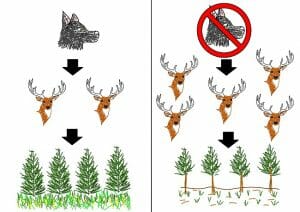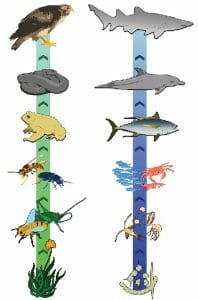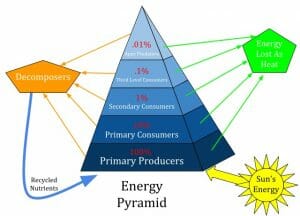Tertiary Consumer Definition
A tertiary consumer is an animal that obtains its nutrition by eating primary consumers and secondary consumers. Usually tertiary consumers are carnivorous predators, although they may also be omnivores, which are animals that feed on both meat and plant material.
Function of Tertiary Consumers
Within any ecosystem, the energy that is present within its organisms is passed through a food chain or food web. Each organism in a food chain occupies a particular position called a trophic level, whereby animals consume other animals in lower trophic levels and are eaten by those in higher trophic levels.
Tertiary consumers often occupy the top trophic level, and so are predated by no other animals; in this case they are called “apex predators”. However, when they die their bodies will be consumed by scavengers and decomposers.
Sometimes in a food chain there is an apex predator above the tertiary consumer. However, energy is used up and is lost as heat as it is transferred through each of the trophic levels, which results in a low availability of energy in the higher levels (this can be viewed as an energy pyramid). It is therefore common to only have four trophic levels, and for the tertiary consumer to hold the ecological function of the apex predator.
Species in the highest trophic levels play a very important role in ecosystems. They control populations or alter the behaviour of animals in lower trophic levels. Animals in lower trophic levels may be carnivores, herbivores or omnivores, and when their populations are limited it relieves either predation or grazing pressure on the trophic levels below them. This keeps ecosystem dynamics in balance. For example, if a population of foxes becomes too large it could put pressure on rabbit populations. By predating the foxes, a tertiary consumer, such as a hawk, keeps the populations in check and reduces the amount of rabbits that are consumed by the foxes. This is called a trophic cascade.

The image shows an example of a trophic cascade. When the predator is present the deer population is controlled, however, if predators are removed deer populations grow and this can affect the vegetation of an ecosystem.
Examples of Tertiary Consumers
Big Cats
All big cats, such as tigers, lions, pumas and jaguars are tertiary consumers. They are also all apex predators, meaning they have no predators in their natural environment—an exception to this is the leopard, which is occasionally predated by lions and tigers, with which they share habitats.
The physical features of the big cats are typical of apex predators. They have large teeth, jaws and claws; they have forward facing eyes for tracking prey; they also have strong muscles and can often run at great speed.
Big cats consume prey from all trophic levels beneath them. This includes herbivores that live in herds such as buffalo, zebras and wildebeest, and secondary consumers such as foxes and hyenas. They also sometimes consume large animals such as crocodiles when on land, although when in the water, the crocodiles—which are also tertiary consumers—have an advantage, and the big cats can become vulnerable to attack.
Marine Tertiary Consumers
There are many examples of tertiary consumers in marine ecosystems. The primary producers of the oceans, phytoplankton, are generally consumed by microscopic organisms called zooplankton, and so the numerous animals that feed on the zooplankton are secondary consumers. Fish, jellyfish and crustaceans are common secondary consumers, although basking sharks and some whales also feed on the zooplankton.
Phytoplankton are extremely numerous, and supply ecosystems with a huge amount of biomass and thus provide lots of energy within the trophic pyramid. Because there is such a large amount of available energy, the secondary consumers (fish etc.) are also numerous and many animals feed on them.
Tertiary consumers in marine environments include larger fish such as tuna, barracuda and groupers, seals and sea lions, jellyfish, dolphins, moray eels, turtles, sharks and whales—some of which are apex predators, such as the great white or tiger sharks and orca whales. Additionally, many seabirds such as gulls, shearwaters and penguins are tertiary consumers.

The image shows a simplified example of a food chain in a terrestrial (left) and a marine environment (marine).
In freshwater environments, predatory fish, such as pike, consume smaller fish as well as other secondary consumers such as frogs, snakes, birds and small mammals.
Humans
Humans are omnivorous, meaning they eat both plant and animal materials. They also have a widely varied diet and so consume foods from every trophic level, including decomposers such as mushrooms!
If a person chooses to be a vegetarian or vegan, they would be classed as a primary consumer as they only eat plant material. By eating foods such as grain-fed chicken, a person would fill the role of secondary consumer, however, if that chicken is also able to eat insects the person is a tertiary consumer.
Humans are often thought of as apex predators, because they have acquired the ability to kill any animal using weapons etc. However, if you took away a person’s gun and put them face to face with a lion…who do you think would be eaten?
Related Biology Terms
- Primary Producers – Autotrophic organisms that use photosynthesis to create their own food using energy from the sun.
- Primary Consumers – Heterotrophic organisms also known as herbivores, which acquire nutrition from consuming primary producers.
- Energy Pyramid – The graphical representation of the flow of energy through the trophic levels of an ecosystem.
- Trophic Cascade – The top-down effect that predators have on populations of prey within an ecosystem.
Quiz
1. Which of the following describes a tertiary consumer?
A. An animal that eats other carnivorous or omnivorous animals
B. An herbivorous animal
C. A fast animal
D. An animal in the third trophic level
2. Which of the following is an example of a tertiary consumer?
A. Mouse
B. Tarantula
C. Hawk
D. Toad
3. Which of the following is not a typical feature of an apex predator?
A. Sharp claws
B. Strong muscles
C. Thick fur
D. Speed
Tertiary Consumer

No comments:
Post a Comment